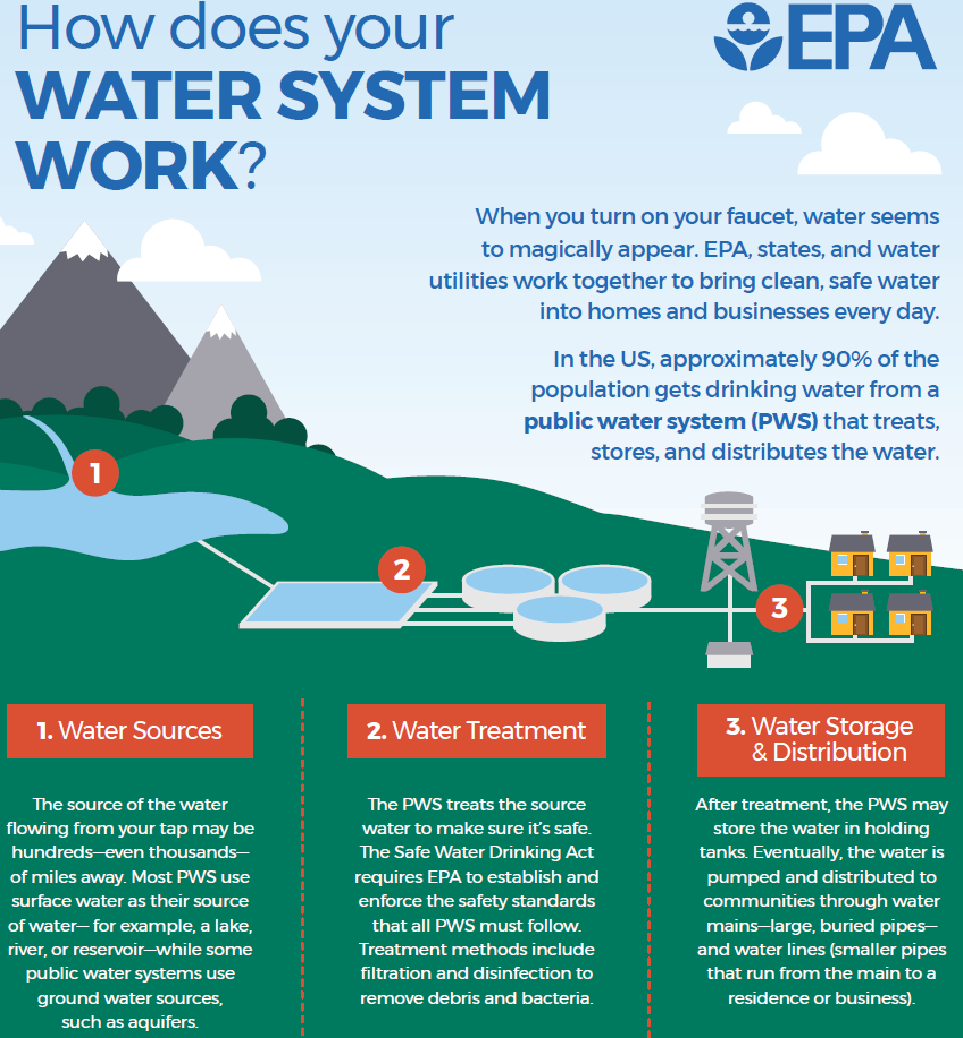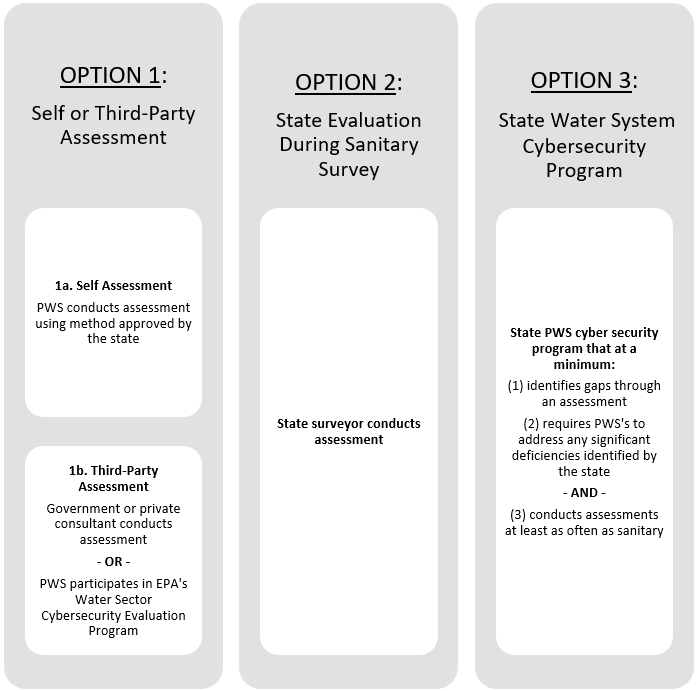[authors: Kim Logue, John Peiserich, and Ron Yearwood, Jr.]
EPA Aims to Mitigate Risk of Cyberattack on Public Water Systems
On March 3, 2023, the U.S. Environmental Protection Agency (EPA) issued its Memorandum Addressing Public Water System (PWS) Cybersecurity in Sanitary Surveys or an Alternate Process to expand state audits of water systems to include an evaluation of operational technology cybersecurity. The memorandum states, “While PWSs have taken important steps to improve their cybersecurity, a recent survey and reports of cyber-attacks show that many PWSs have failed to adopt basic cybersecurity best practices and consequently are at high risk of being victimized by cyber-attack—whether from an individual, criminal collective, or a sophisticated state or state sponsored actor.” The memorandum was issued a day after the White House released a comprehensive cybersecurity plan aimed at mitigating breach threats to government agencies, industry, schools, hospitals, and other key infrastructure.
Why Is This Important and Who Is Impacted?
Public Water Systems are the primary source of drinking water for approximately 90% of all Americans. Under the Safe Drinking Water Act (SDWA), public water systems are regulated by the EPA. The EPA establishes and enforces standards to ensure the safety of everyone’s drinking water. One of the several items that are mandated by the SDWA is the annual Consumer Confidence Report. That report which must be sent to all customers includes the following information:
- The lake, river, aquifer, or other source of the drinking water.
- A brief summary of the risk of contamination of the local drinking water source.
- The regulated contaminant found in local drinking water.
- The potential health effects of any contaminant detected in violation of an EPA health standard.
- An accounting of the system's actions to restore safe drinking water.
- An educational statement for vulnerable populations about avoiding Cryptosporidium.
- Educational information on nitrate, arsenic, or lead in areas where these contaminants may be a concern.
- Phone numbers of additional sources of information, including the water system.
- EPA's Safe Drinking Water Hotline number 1-800-426-4791.
There are approximately 155,693 public water systems in the United States. They are classified in three tiers:

Figure 1 - U.S. public water system types (Source: EPA).
In 2007, for example, over 286 million Americans received their tap water from a community water system. Below is a description of how water systems work. In the last several years, information technology systems have been increasingly built into this process to enhance treatment and delivery. However, introduction of technology also presents potential risk.

Figure 2 - How public water systems work (Source: EPA).
Infrastructure elements, including water processing and delivery, have traditionally struggled with the concept of integrating information technology (IT) with operational technology (OT). This integration becomes even more challenging with the introduction of “Internet of Things” (IOT) devices added to the PWS ecosystem. These IT and OT advancements, including industrial control systems and supervisory control and data acquisition systems (ICS/SCADA), which can automate many elements of OT and improve the ability to monitor and control, can also increase risk. The potential risk is not just a systems breach but the interruption of critical services vital to our country, including power, telecommunications, roadways, and, yes, water. Like other government and municipal entities, water utilities have budget limitations. Accordingly, introducing new IT that requires ongoing updates, monitoring, and maintenance, necessitates additional investment to defend against public safety and national security threats to these critical infrastructure elements. It is a horrible day when corporate America is attacked. It can be deadly if water supplies are impacted.
What Is the Regulatory Basis for the New Cybersecurity Requirement?
Under the authority of the SDWA, 40 CFR § 142.16(b)(3) and (o)(2) already required states to conduct periodic audits or “sanitary surveys” of PWSs. In particular, the regulations require that these sanitary surveys include “an onsite review of the water source (identifying sources of contamination using results of source water assessments where available), facilities, equipment, operation, maintenance, and monitoring compliance of a public water system to evaluate the adequacy of the system, its sources and operations, and the distribution of safe drinking water.” 40 CFR § 142.16(b)(3). The EPA’s memorandum states that the new cybersecurity evaluation requirement merely clarifies what is meant to be included in the onsite review of “equipment” and “operation.” It is through this interpretation—and not any modification of existing regulations—that the EPA will now require states to include a cybersecurity review when conducting sanitary surveys. EPA’s memorandum identifies different approaches for states to fulfill this responsibility and provides a list of questions they may use in conducting the assessment.
How Will the States Conduct Cybersecurity Review?
The memorandum allows states to adopt one of three options for incorporating cybersecurity review into PWS sanitary surveys. As shown in the table below, states may utilize 1) PWS or third-party assessment, 2) state evaluation during the sanitary survey, or 3) an existing state water system cybersecurity program that is at least as stringent as a sanitary survey. Importantly, if a state allows PWSs to conduct their own cybersecurity evaluations or hire a third party, the assessment must be completed prior to the state sanitary survey. The state may also require the PWS to develop a risk mitigation plan prior to the sanitary survey to address any cybersecurity gaps that are identified during a self-assessment. Any method used for self-assessment would need to be conducted using a government or other state-approved method. Any private third party conducting the assessment would similarly need to be approved by the state.

Figure 3 - Options for incorporating cybersecurity review into PWS sanitary surveys.
What Is the Immediate Industry Response to the Memorandum?
Industry response to the EPA’s new cybersecurity assessment requirement for PWSs has been mixed. Mike Hamilton, former chief security officer for the City of Seattle, commented that limiting approved assessment methodology to government or state-approved methods “make[s] this activity hard to scale across the breadth of water utilities across the country.” Tracy Mehan, executive director of government affairs at the American Water Works Association, similarly warns that the plan puts states in a tough position by directing that cybersecurity reporting should start immediately.
Integration of the EPA’s new cybersecurity assessment into PWS operations may depend on the current state of the utility. Facilities with integrated IT and OT that have any outward or public facing network elements likely already have a robust cybersecurity program. If not, they will likely have a steep hill to climb to successfully complete the EPA’s mandated cybersecurity assessment and will need to begin securing their networks expeditiously. If IT and OT are still separated, there may be less risk of a significant gap now being identified during state sanitary surveys, but this does not mean that immediate action will not still be necessary; rather, the potential impact of a cyberattack is segregated based on the isolated nature of the OT environment. Action to protect internet facing network elements will still be required. If a utility cannot bill or track service, it is effectively shut down, which may present a public safety or national security threat.
Conversely, reliance on the EPA’s memorandum alone may not be enough to secure the nation’s water supply. Tied to the current requirements for community and non-community state sanitary surveys, PWS cybersecurity assessments will be necessary once every three or five years, or more frequently where appropriate. Cybersecurity good practices typically suggest more frequent and ongoing assessment.
What Can PWSs Do Now to Accelerate Compliance with the New Requirement?
With its memorandum, EPA provides an optional checklist that states may use during a sanitary survey to evaluate the cybersecurity of a PWS’s operational technology. Prior to the rule coming into effect, if a state does not elect to implement a self- or third-party assessment, PWSs should give serious consideration to this checklist and take steps to develop a plan that includes creating internal accountability and conducting an informal cybersecurity review sufficiently in advance of any upcoming sanitary survey to allow for implementation of corrective good practices prior to state assessment. Additional guidance can be found in the EPA publication, “Evaluating Cybersecurity During Public Water System Sanitary Surveys.”
For some PWSs, this will be starting from scratch. They should start with the EPA checklist (shown below) and other free tools available to establish a picture of the current state and begin working on enhancing their ability to defend against and respond to cyberattack. PWSs can also look to trusted third party consultants to help them down this path.
How to Prepare Your PWS to Comply with the EPA’s New Cybersecurity Requirements
Professionals with expertise in Environmental Compliance audits and program evaluation, Enterprise Risk Management program development and evaluation, and Cyber Security risk assessment and mitigation can help impacted organizations prepare for compliance. Additionally, the right experts can provide custom operational, programmatic, and governance-oriented solutions, assisting a PWS in beginning the journey toward enhanced cyber security, including developing a roadmap to compliance with EPA’s new cybersecurity requirements prior to future state sanitary surveys.
1https://www.cdc.gov/healthywater/drinking/public/index.html